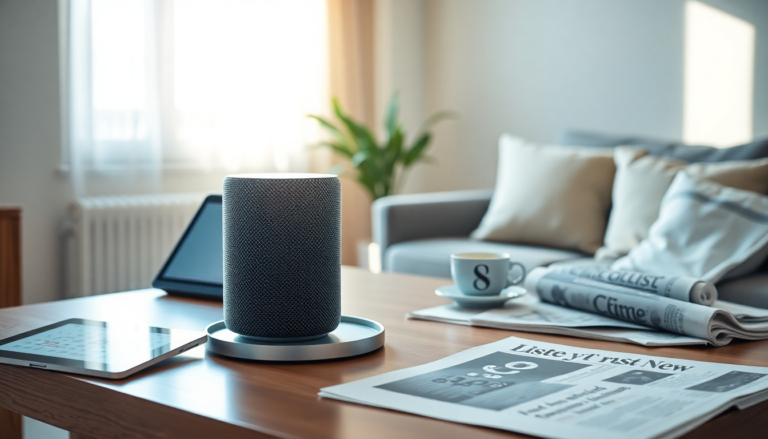Argomenti trattati
Imagine waking up and simply saying, “Good morning!” and having your smart speaker respond with the day’s weather, news updates, and even your schedule. This isn’t just a futuristic fantasy—it’s the reality today, and it’s fueling a massive boom in the smart speaker market. As of 2024, this market was valued at a whopping $9.60 billion, and projections indicate it could skyrocket to $57.48 billion by 2033. But what’s driving this growth, and what barriers do we face? Let’s delve deep into the intricacies of this technological revolution.
Growth drivers in the smart speaker market
One of the most significant catalysts for the surge in smart speaker adoption is the increasing integration of smart home technology. As more households embrace the convenience of IoT devices, smart speakers have become the central command hub for managing everything from lighting to security systems. I remember when I first set up my own smart home—talk about a game changer! With a simple voice command, I could control my entire environment, making life not just easier but also more enjoyable. This hands-free comfort is what consumers crave.
The growth of smart home technology is set to continue. According to IoT Analytics, the number of connected devices is projected to grow by 13% by 2024, reaching a staggering 16.6 billion. This dramatic increase will undoubtedly solidify smart speakers’ roles as critical components of smart home ecosystems. With the push for connectivity and automation, it’s clear that smart speakers are just getting started.
Advancements in voice recognition and AI technology
Another cornerstone of this booming market is the rapid advancement in AI-powered virtual assistants. Think of Amazon Alexa, Google Assistant, and Apple Siri—these technologies have transformed smart speakers into more than just devices; they are companions of sorts. Enhanced speech recognition and contextual understanding have made interactions feel natural and intuitive. And let’s not forget the added accessibility features that benefit visually impaired users and the elderly—something that’s close to my heart as I’ve seen how technology can empower those who need it most.
The sophistication of AI behind these speakers is evolving at breakneck speed. The more we refine voice recognition technology, the more applications we uncover across various sectors. From healthcare to education, the possibilities are endless. The future seems bright, doesn’t it?
Consumer demand for hands-free convenience
In our fast-paced world, who wouldn’t appreciate the convenience of a voice-activated assistant? Whether you’re juggling work, family, or social obligations, smart speakers provide a seamless way to manage daily tasks. You can set reminders, manage your calendar, or even catch up on the latest news—all with a simple voice command. The ease of use and multifunctionality have made them a staple in homes and offices alike. Did you know that as of 2025, there are projected to be 153.5 million voice assistant users in the U.S. alone? It’s a staggering number, reflecting just how ingrained these devices have become in our lives.
Moreover, the trend of integrating voice technology into cars, hotels, and public spaces is gaining momentum. Imagine checking into a hotel and controlling the ambiance of your room solely through voice commands. It’s not just about novelty; it’s about making life smoother and more efficient. Personally, I believe that as we continue to embrace this technology, we’ll find even more innovative applications that will further integrate into our daily routines.
Challenges in the smart speaker market
Yet, amid the excitement and growth, there are significant challenges that the smart speaker market must navigate. Privacy and data security issues loom large. With devices that are always listening, concerns about data privacy are understandably high. Customers are increasingly wary of how their information is collected and used. High-profile data breaches have cast a shadow over the industry, leading to a surge in skepticism among users. Companies must step up their game—introducing robust data protection measures and allowing users greater control over their personal information.
Language support is another hurdle that manufacturers face. Despite advancements in AI, many smart speakers still struggle with dialects and languages beyond English. This limitation restricts their appeal in non-English speaking markets and hinders global expansion. As many know, addressing these linguistic barriers will require substantial investments in data collection and AI training. Companies that ignore this challenge risk missing out on vast markets waiting to adopt this technology.
Looking ahead: The future of smart speakers
As we peer into the crystal ball, the outlook for smart speakers appears promising but fraught with challenges. The continuous evolution of AI and IoT technology will likely push the boundaries of what these devices can do, fostering even greater adoption rates. However, manufacturers must prioritize consumer trust by addressing privacy concerns and expanding language support. Only then can they fully tap into the potential of this burgeoning market.
In my view, the smart speaker market is not just a fleeting trend; it’s a glimpse into the future of technology in our lives. As we move toward more connected homes, the integration of smart speakers will be pivotal. So, the next time you find yourself talking to your speaker, remember you’re part of a revolution that’s reshaping how we interact with technology and each other.

